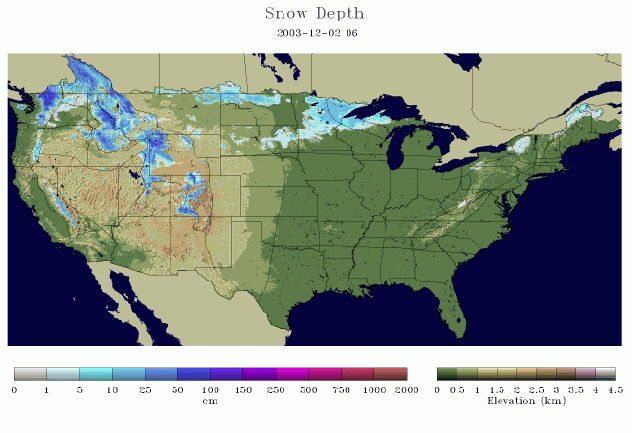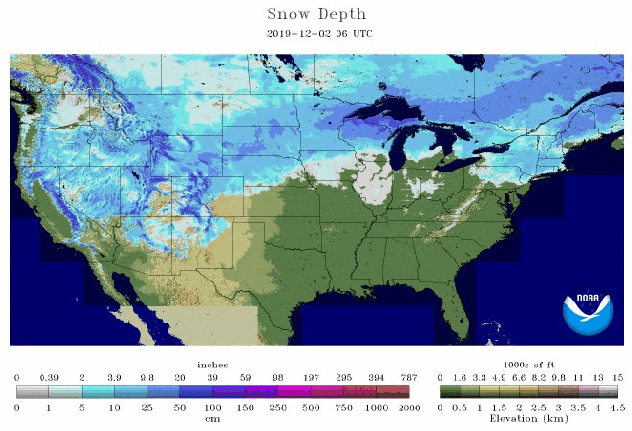Where's the snow? Snow coverage in US for early December lowest in 18 years
 |
U.S. snow depth on December 2, shown each year from 2003 to 2021. (NWS) |
It's December, for those of you who don't own calendars.
But our calendarless neighbors can be excused for thinking it may be November or even October based on the current color of their grass. Americans from the Pacific to the Atlantic are putting up Christmas lights and lighting menorah candles without the usual wintry scene-setter - wintry, white, blanketing snow. So where's it at?
Well, almost nowhere in the United States, apparently.
As of Dec. 3, just 6.0% of the contiguous U.S. is covered by snow, according to data from the National Weather Service (NWS). That's the lowest amount of snow coverage at this time of year since 2003, the first year records on contiguous U.S. snow coverage were tracked. At this time in 2020, that figure was 16.9%, and in 2019, nearly half the country was covered in snow, as 45.4% of the nation was blanketed.
Snow depth maps from Dec. 2, 2019, and Dec. 2, 2021, highlight those vast differences.
 |
U.S. snow depth on Dec. 2, 2019, compared to Dec. 2, 2021. (NWS) |
And it's not just that many states in the country haven't seen the usual snow amounts yet. On the opposite end of the temperature spectrum, conditions are historically warm in many areas of the nation, even record-breaking in some spots.
Throughout California, high-temperature records for the month of December fell on Wednesday, including in Palm Springs, where a high of 91 degrees Fahrenheit was the daily record high. Records fell across Texas and Kansas as well on Thursday, like in San Angelo, Texas, where the old record of 83 F was broken when the temperature rose to 85. on Friday, records fell across New Mexico and Arkansas, as well as into the Southeast. Rosewell, New Mexico, set a new record of 82 F.
According to AccuWeather Meteorologist Ryan Adamson, that warmth is far from over and will even expand farther to the east over the next several days, leaving temperature records in peril for areas such as Oklahoma City, Lubbock, Texas, and Little Rock, Arkansas, just to name a few.
 |
In Denver, residents are still waiting for the city's first measurable snowfall of the season, the latest it has ever arrived. Instead of snow, on the first day of December, the city got something much different.
"Denver tied its daily record of 73 degrees originally set in 1973. This also continued Denver's streak of no measurable snow (0.1 of an inch or greater) so far this season," Adamson said. "The previous record for the latest first measurable snow was Nov. 21, 1934, so a new record will continue to be established each day until measurable snow finally occurs."
AccuWeather National Reporter Tony Laubach recently moved back to Colorado and said it's been a bit of a bummer to go this long without snow.
"Coming back to Colorado for the first time, it's definitely a downer that we're now into the first week of December, and we have not seen snow yet in many spots, and what has fallen has been so little," he said. "A snowless fall in Colorado hurts me more than a not-so-white Christmas. Really, all I want at this point is snow, and the sooner on the calendar the better."
Those sentiments are likely shared by residents throughout the U.S., not just those in the western half of the country.
In the northern Plains, Taylor Foster of Spearfish, South Dakota, told AccuWeather that while she has grown accustomed to milder winters in recent years, this year's rendition "seems even more extreme."
"We usually have had some major snowstorms by this time of year. Right now, there's green grass in my front yard," she said. "It's been 70 degrees the past two days, when normally it's freezing temperatures."
Foster added that although she's not the biggest fan of the snow, she's concerned about what the lack of precipitation means because the snow is necessary to replenish the underground water supply and keep drought conditions at bay. Plus, local ski resorts have already begun feeling the sting of a slow-starting winter.
"There's a ski mountain in Spearfish that hasn't opened yet," she said. "I feel bad for the people who bought their season passes."
 |
To the east, some snow has fallen in areas around the Great Lakes and Northeast like normal this year, but those farther south, in the southern Appalachians and southern Ohio Valley, have also been left empty-handed.
Compared to Decembers in which much snow has fallen early, like last year, the wintry precipitation is not only lacking but potentially unlikely to arrive anytime soon. Even as a cold front is forecast to sweep through the country early next week, high temperatures in the Southeast will still likely trend above average.
"While temperatures will no longer challenge records behind the front in the Southeast, highs will still likely be near to slightly above normal," Adamson said. "As a result, the cooling will be much less noticeable as compared to areas farther to the north and west."
As AccuWeather long-range meteorologists pointed to in the 2021 edition of the annual white Christmas forecast, residents of lower latitude states and in the country's heartland may be left disappointed if they're holding out hope for a scenic Christmas morning.
In Denver, Laubach said he wouldn't care about missing out on a white Christmas, partially because of how many years he's spent living in less snowy areas, and also from " working in TV weather where if there was a white Christmas, I was working those Christmas days" anyway.
But in warm Texas, at least one weather enthusiast, Jackson Desmond of Mansfield, Texas, is hanging on to a different ambition.
Please God PLEASE I NEED THIS https://t.co/TQaQN8pdnB
— DFWStormChasers🇺🇲 (@DFWStormChasers) December 1, 2021
"Though chances are low, I am still holding out hope for a white Christmas as it would be the first time one has occurred in DFW since 2011," Desmond said in a message, adding that he believes the shift in weather this winter doesn't entirely rule out snow, "but it seems that our chances will most likely be after Christmas."
Residents in areas around the Great Lakes may be reading this news with disbelief, as heavy lake-effect snow has fallen in recent weeks.
For parts of eastern Wisconsin, in particular, the snow was dense enough to account for multiple snow days in heavily populated areas. A high of 7 inches of snow was recorded in the town of Mountain, Wisconsin, on Nov. 30, allowing local winter sports enthusiasts to flock to nearby mountains to start the ski season.
 |
Michigan State's Jayden Reed, left, catches a pass for a 20-yard touchdown on a fourth-and-15 against Penn State's Johnny Dixon (3) during the fourth quarter of an NCAA college football game, Saturday, Nov. 27, 2021, in East Lansing, Mich. Michigan State won 30-27. (AP Photo/Al Goldis) |
Over Thanksgiving weekend, lake-effect snow fell across parts of northern Michigan, adding to the drama for some high-stakes, late-season football games. The matchup in East Lansing between Michigan State University and Penn State University, which was decided by a field goal, was played in steady snowfall and the field was covered almost from the opening kickoff.
Multiple clipper storms have also dumped snow into areas of upstate New York and northern New England, aligning with the prognostications from the annual AccuWeather U.S. winter forecast published back in September.
"This winter, I think, is going to be a colder one, at least for the interior sections from the Appalachians to the Ohio Valley and Great Lakes," AccuWeather Senior Meteorologist Paul Pastelok said at the time. So far, it's certainly shaping up that way even before the official arrival of winter.
The latest weather news check back on AccuWeather.com. Watch the AccuWeather Network on DIRECTV, Frontier, Spectrum, fuboTV, Philo, and Verizon Fios. AccuWeather Now is now available on your preferred streaming platform.





